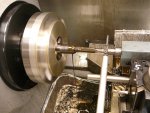I have researched all I can find on different ways to hold a reamer in a manual lathe. I have come to the conclusion that a rigid set up seams to cut the truest chambers if everything is set up perfectly concentric and on the same axis of the spindle. It seams floating style holders are used to to cover up any error in the set up, but have their own set of problems.
I was kicking around the idea of using an MT3 er32 collet chuck in the tailstock. As far as truing the tailstock goes, its adjustable in and out, but not up and down. I am also reading that the height of the tailstock varies dependent on temperature and position on the ways. Also with the quill going in and out, this is one more thing to try to get perfect across the whole length of travel. This tailstock method doesn't seem to be the best with a rigid set up.
This leads to a collet chuck in a boring bar holder on the tool post on the carriage. This would be adjustable up, down, in, and out. How rigid of a set up is using the carriage? Are there any other downfalls to using the carriage other than having to dial it in for every chamber?
Are there any other rigid reamer holder set ups that I'm missing on a manual lathe? What is the preferred method?
Thanks,
I was kicking around the idea of using an MT3 er32 collet chuck in the tailstock. As far as truing the tailstock goes, its adjustable in and out, but not up and down. I am also reading that the height of the tailstock varies dependent on temperature and position on the ways. Also with the quill going in and out, this is one more thing to try to get perfect across the whole length of travel. This tailstock method doesn't seem to be the best with a rigid set up.
This leads to a collet chuck in a boring bar holder on the tool post on the carriage. This would be adjustable up, down, in, and out. How rigid of a set up is using the carriage? Are there any other downfalls to using the carriage other than having to dial it in for every chamber?
Are there any other rigid reamer holder set ups that I'm missing on a manual lathe? What is the preferred method?
Thanks,


